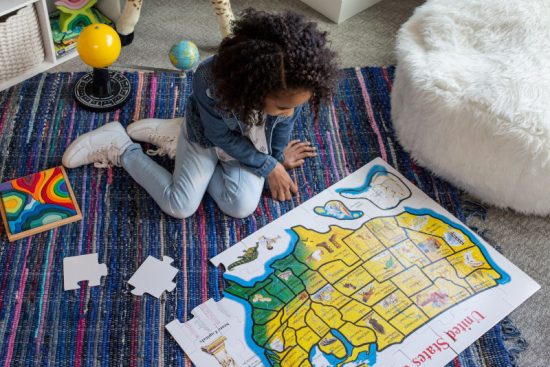
Creating a supportive learning environment at home has become more crucial than ever. With the rise of home-based education, parents are often challenged with how to provide an effective and nurturing setting for their children’s studies.
In this article, we will explore some practical strategies to help you enhance your child’s home learning experience, ensuring they thrive academically and emotionally.
1. Designate a Specific Learning Area
A designated learning area is the cornerstone of an effective home education setup. Having a specific spot for studying helps children distinguish between playtime and learning time, fostering a sense of routine and discipline. Choose a quiet, well-lit area in your home where your child can focus without interruptions. It doesn’t have to be an entire room; a simple corner with a desk and comfortable chair can suffice. Ensure that this space is free from distractions such as toys, television, and loud noises. Personalize it with educational posters, a whiteboard, and necessary supplies to create an inviting and functional study area.
2. Support Your Child’s Mental and Emotional Well-being
Supporting your child’s mental and emotional well-being is just as important as their academic progress. Working with a professional who meets the necessary clinical social worker requirements can provide invaluable assistance in this regard. These professionals are trained to address various psychological and social issues that might affect your child’s learning experience. They can offer strategies to manage stress, anxiety, and other emotional challenges. To find a qualified clinical social worker, you can ask for recommendations from your child’s school, healthcare providers, or local community centers. Collaborating with a social worker ensures your child receives the holistic support they need to succeed in their studies.
3. Establish a Consistent Routine
A consistent daily routine is essential for maintaining a structured learning environment. Children thrive on predictability, and having a set schedule helps them understand what is expected of them each day. Start by setting regular hours for waking up, meals, study sessions, and bedtime. Include breaks and recreational activities to balance the academic workload. A well-planned routine minimizes stress and helps children develop time management skills. Additionally, involve your child in creating the schedule to give them a sense of ownership and responsibility over their daily activities. Consistency in routine promotes discipline and enhances learning outcomes.
4. Create a Distraction-Free Zone
Distractions can significantly hinder your child’s ability to concentrate on their studies. To create a distraction-free learning zone, identify potential sources of disruption and address them proactively. This might involve setting up the study area away from high-traffic parts of the house or using noise-canceling headphones to block out background noise. Limit the use of electronic devices during study time unless they are necessary for educational purposes. Encourage siblings and other family members to respect the learning space by keeping noise levels down and avoiding interruptions. A calm and quiet environment helps your child stay focused and improves their ability to retain information.
5. Provide Access to Necessary Resources
Ensuring your child has access to all the necessary resources is critical for a productive learning experience. Start by stocking up on basic supplies such as notebooks, pens, pencils, and textbooks. Additionally, invest in a reliable internet connection and a computer or tablet, as many educational activities and resources are now available online.

Utilize free online resources, such as educational websites and virtual libraries, to supplement your child’s learning. Keep the study area well-organized, with all materials within easy reach to minimize disruptions. Providing the right tools and resources empowers your child to engage fully in their studies and achieve their academic goals.
6. Encourage Open and Honest Communication
Open and honest communication between you and your child is essential for a supportive learning environment. Regularly check in with your child about their academic progress and any challenges they might be facing. Create a safe space where your child feels comfortable sharing their thoughts and concerns without fear of judgment. Active listening is crucial—show empathy and understanding when your child speaks. By maintaining open lines of communication, you can identify issues early and provide the necessary support. This approach not only helps in academic matters but also strengthens your relationship with your child, fostering a sense of trust and security.
7. Foster a Positive Learning Atmosphere
A positive learning atmosphere is key to keeping your child motivated and engaged. Celebrate their achievements, no matter how small, to boost their confidence and enthusiasm for learning. Use positive reinforcement to encourage good study habits and effort. Create an environment where mistakes are seen as learning opportunities rather than failures. This mindset helps build resilience and a growth mindset in your child. Additionally, ensure that the learning space is filled with inspiring and educational materials, such as books, puzzles, and educational games. A positive and encouraging atmosphere makes learning enjoyable and instills a lifelong love for education.
8. Integrate Breaks and Physical Activity into the Day
Breaks and physical activity are vital for maintaining your child’s focus and overall well-being. Incorporate short breaks between study sessions to prevent burnout and keep your child refreshed. Encourage physical activity during these breaks, such as stretching, playing outside, or doing a quick workout. Physical activity not only helps in reducing stress but also enhances cognitive function and concentration. Create a balanced schedule that includes ample time for movement and relaxation. This holistic approach ensures that your child remains physically active, mentally sharp, and ready to tackle their academic tasks with renewed energy.
9. Stay Involved and Engaged in Your Child’s Learning
Staying involved in your child’s learning journey is crucial for their success. Take an active interest in their assignments and projects, and offer assistance when needed. Attend parent-teacher meetings and stay informed about their academic progress. Engage in discussions about what they are learning and encourage curiosity by asking questions and exploring topics together.

Your involvement shows your child that their education is important and valued. Additionally, it provides opportunities for experiential learning through educational trips, science experiments, and hands-on activities. Staying engaged not only supports your child’s academic growth but also fosters a deeper connection between you and your child.
10. Adapt and Be Flexible with Your Approach
Flexibility is key when it comes to creating a supportive learning environment. Understand that every child is unique, and their needs and preferences may change over time. Be open to adjusting your approach based on what works best for your child. For instance, if a particular study method isn’t effective, try different techniques until you find one that resonates with your child. Stay updated with new educational tools and resources that can enhance your child’s learning experience. Encourage feedback from your child about what they find helpful or challenging. Being adaptable and responsive to your child’s needs ensures that the learning environment remains supportive and conducive to their success.
Conclusion
Creating a supportive learning environment at home is a multifaceted task that requires dedication, understanding, and flexibility. By designating a specific learning area, collaborating with a clinical social worker, establishing a consistent routine, creating a distraction-free zone, and providing access to necessary resources, you lay the foundation for a successful learning experience. Encouraging open communication, fostering a positive atmosphere, integrating breaks and physical activity, staying involved, and being adaptable further enhance this environment. Each of these strategies contributes to a holistic approach that not only supports your child’s academic achievements but also their overall well-being. Remember, the goal is to create a nurturing and engaging space where your child can thrive and develop a lifelong love for learning.




